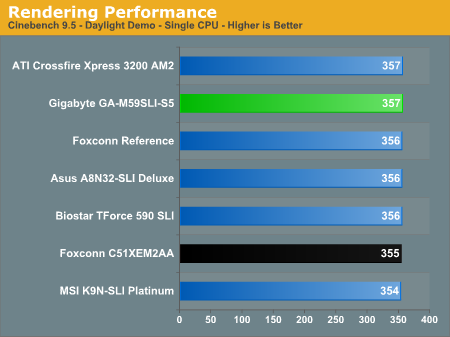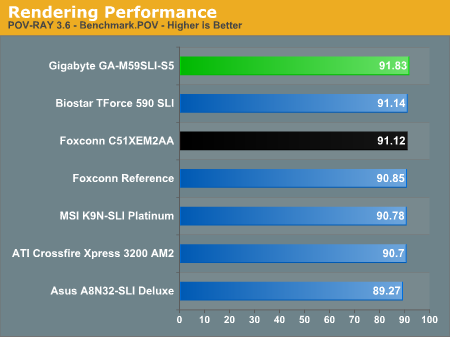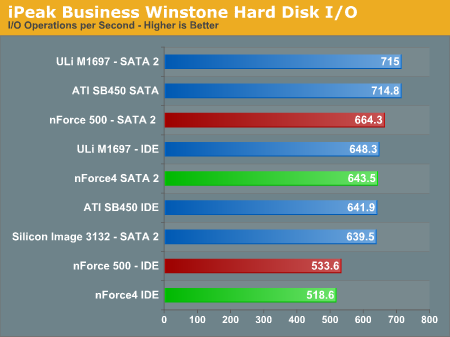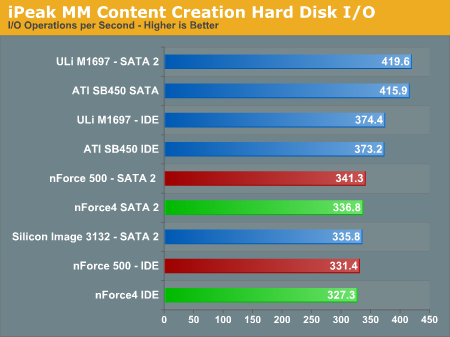Foxconn and Gigabyte Tackle Socket AM2
by Jarred Walton on June 22, 2006 1:30 AM EST- Posted in
- Motherboards
3D Rendering
We ran a couple publicly available 3D rendering applications along with our iPEAK hard disk controller performance tests. The chipset of choice can play a large role in the iPEAK scores, whereas the 3D rendering performance generally stresses the CPU more than anything else, though the memory subsystem can also play a part.



In 3D rendering, the results are all close enough that we would basically call it a tie. The difference between the fastest and slowest motherboard is less than 1%, and it's worth noting that base CPU clock speeds may be slightly higher on some motherboards -- for example, at least one board had a 200.9 MHz HTT bus when set to 200 MHz. We aren't really concerned about the minor overclock, but that also means the margin for error in terms of absolute performance is at least 1%. The end result is that 3D rendering performance is as stated a tie.
I/O Performance


There are differences in iPEAK performance, but the differences are generally confined to the chipset being used. While pure theoretical hard drive performance might be interesting to some people, in most tasks the hard drive is not the bottleneck. If you are truly concerned with hard drive performance, you should take a look at our storage reviews -- we should be adding several new articles in this area shortly.
We ran a couple publicly available 3D rendering applications along with our iPEAK hard disk controller performance tests. The chipset of choice can play a large role in the iPEAK scores, whereas the 3D rendering performance generally stresses the CPU more than anything else, though the memory subsystem can also play a part.



In 3D rendering, the results are all close enough that we would basically call it a tie. The difference between the fastest and slowest motherboard is less than 1%, and it's worth noting that base CPU clock speeds may be slightly higher on some motherboards -- for example, at least one board had a 200.9 MHz HTT bus when set to 200 MHz. We aren't really concerned about the minor overclock, but that also means the margin for error in terms of absolute performance is at least 1%. The end result is that 3D rendering performance is as stated a tie.
I/O Performance


There are differences in iPEAK performance, but the differences are generally confined to the chipset being used. While pure theoretical hard drive performance might be interesting to some people, in most tasks the hard drive is not the bottleneck. If you are truly concerned with hard drive performance, you should take a look at our storage reviews -- we should be adding several new articles in this area shortly.










36 Comments
View All Comments
JarredWalton - Thursday, June 22, 2006 - link
You are correct: there was a bit of confusion between Gary and myself (he was hoping to validate benchmarks). Somewhere along the way I thought that he actually managed to get the Foxconn board running at 332, but in reviewing my e-mail he maxed out at 314 or something. He has a pre-release Board where as I have the retail shipping Foxconn motherboard, so my results were supposed be used. I have corrected this information now. :-)JarredWalton - Thursday, June 22, 2006 - link
hoping = helping. Sorry.glennpratt - Thursday, June 22, 2006 - link
If you got your specs right, then the Foxconn (ALC882D) has Dolby Digital Live.... HUGE DIFFERENCE.ALC882D features Dolby® Digital Live output for consumer equipment
http://www.realtek.com.tw/products/products1-2.asp...">http://www.realtek.com.tw/products/products1-2.asp...
JarredWalton - Thursday, June 22, 2006 - link
Yes, they are accurate. Dolby Digital Live support does make the 882D technically superior, but I'm not sure either one is really all that different in actual practice. I used both motherboards, and at least with games I really would be hard-pressed to tell which was which.glennpratt - Thursday, June 22, 2006 - link
Well, DDL support means that you can go direct into your reciever with AC3 digital sound over SPDIF/TOSLINK, so A) you don't have to use crappy onboard DACs and B) you don't need a big mess of wires to get six channel out. AKA, what we all loved about SoundStorm and nForce 1/2.IMO, if DDL functions properly and that's what you wan't to use, then you have no reason to spend $80-$130 they are charging for DDL soundcards these days.
JarredWalton - Thursday, June 22, 2006 - link
I have updated the text slightly now.